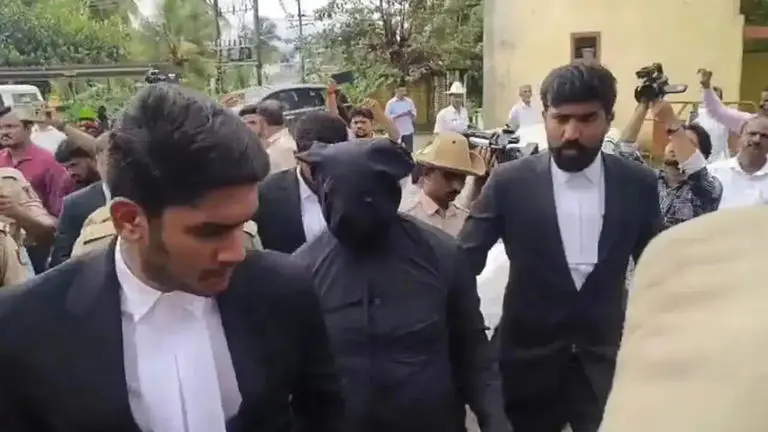
A former sanitation worker’s explosive testimony has triggered a criminal investigation into mass graves, missing women, and systemic abuse
Dharmasthala Unearthed Horror – In the heart of Karnataka’s spiritual landscape lies Dharmasthala, a revered pilgrimage town known for its centuries-old temple, cultural harmony, and charitable legacy. But beneath its sacred soil, a chilling mystery has surfaced one that threatens to unravel decades of silence, fear, and alleged atrocities. A former sanitation worker’s explosive testimony has triggered a criminal investigation into mass graves, missing women, and systemic abuse, casting a dark shadow over a place once synonymous with peace.
The Whistleblower’s Revelation: A Tale Buried in Bones
On July 3, 2025, a man who once worked as a sanitation worker for the Dharmasthala temple administration filed a complaint that shook the conscience of the nation. In his letter to the police, he claimed that between 1995 and 2014, he was coerced into burying or burning the bodies of over 100 women and minors, many of whom bore signs of sexual assault, strangulation, and acid burns.
His testimony, backed by photographic evidence of skeletal remains, was not just a cry for justice it was a confession of guilt, fear, and trauma. He appeared in court under heavy protection, his identity concealed, and offered to identify burial sites and name perpetrators, provided he was granted safety under the Witness Protection Act, 2018.
Sacred Ground or Silent Graveyard?
Dharmasthala is no ordinary town. It is home to the Lord Manjunatha shrine, administered by the influential Heggade family, with rituals conducted by Hindu priests and management overseen by Jains. The temple draws thousands of devotees annually, including politicians and celebrities.
But the whistleblower’s account paints a disturbing picture: bodies buried along the Netravathi River, near petrol bunks, and in soft soil chosen for rapid decomposition. Victims included schoolgirls in uniform, women with acid-burned faces, and others stripped of dignity before death.
A Pattern of Suppression: Echoes of Sowjanya
This isn’t the first time Dharmasthala has faced allegations of violence and cover-ups. In 2012, the rape and murder of 17-year-old Sowjanya, a student in the town, sparked national outrage. Despite multiple investigations, including by the CBI, no convictions were made. Activists accused authorities of tampering with evidence and shielding powerful suspects.
The current revelations have reignited calls for justice not just for Sowjanya, but for hundreds of unnamed victims whose stories may have been buried with their bodies.
The Missing and the Silenced
Among the most haunting connections is the case of Ananya Bhat, a first-year MBBS student who vanished in 2003 during a college trip to Dharmasthala. Her mother, Sujatha, a former CBI stenographer, recently filed a fresh complaint, convinced her daughter may be among the victims mentioned by the whistleblower.
Sujatha’s own ordeal abduction, assault, and months of unconsciousness adds another layer to the horror. Her return to Dharmasthala, seeking closure and justice, has galvanized public support and intensified demands for a Special Investigation Team (SIT).
Institutional Denial and Legal Roadblocks
Despite the gravity of the allegations, local authorities have been slow to act. The Dakshina Kannada police registered a case under Section 211(a) of the Bharatiya Nyaya Sanhita, but have yet to conduct full exhumations or name suspects. The whistleblower’s lawyers accuse the police of delaying procedures, ignoring burial site visits, and breaching confidentiality.
Meanwhile, BJP MLA Arvind Bellad dismissed the claims as “baseless,” citing Dharmasthala’s reputation for good work. But activists argue that reputation cannot override accountability, especially when lives are at stake.
Forensic Evidence and Judicial Oversight
The whistleblower has already handed over skeletal remains to the police, which are now under forensic examination. Investigators have sought permission for brain mapping, fingerprint analysis, and narco tests, pending the witness’s consent.
Legal experts warn that without judicial oversight and independent inquiry, the case risks being buried—literally and figuratively. The Karnataka State Commission for Women has demanded data on all missing women and students from the region over the past 20 years.
Power, Fear, and the Culture of Silence
The whistleblower’s account reveals a culture of intimidation, where dissent was met with threats like “We will cut you into pieces, your body will be buried like the rest”. His decision to speak out, after years in hiding, was driven by guilt and a desire to give victims a respectful farewell.
He claims that some perpetrators were linked to the temple administration, and fears retaliation if their names are revealed without protection. His legal team has submitted a sealed envelope to Supreme Court advocate KV Dhananjay, containing names of the accused, in case he is harmed.
What Lies Ahead?
The Dharmasthala case is a litmus test for India’s justice system. Will the state confront uncomfortable truths, or will it protect powerful interests? Will the victims be remembered, or will their stories be buried again?
Several outcomes are possible:
- Formation of an SIT to ensure impartial investigation.
- Exhumation of burial sites under judicial supervision.
- Protection and rehabilitation of the whistleblower.
- Public disclosure of forensic findings and missing persons data.
But time is running out. The longer the delay, the greater the risk of evidence being lost, witnesses being silenced, and justice being denied.
Dharmasthala Unearthed Horror – A Town at the Crossroads
Dharmasthala stands at a crossroads between faith and fear, legacy and accountability, silence and truth. The whistleblower’s courage has opened a door that many tried to keep shut. Now, it’s up to the system to walk through it.
This isn’t just a story of buried bones, it’s a story of buried voices. And if those voices are finally heard, Dharmasthala may yet find redemption not through rituals, but through justice.
Vanished Without a Trace: Dharmasthala’s Erased Death Records and the Fight for Justice
1 thought on “Beneath the Pilgrim’s Path: Dharmasthala Unearthed Horror and the Whistleblower Who Broke the Silence”
Comments are closed.